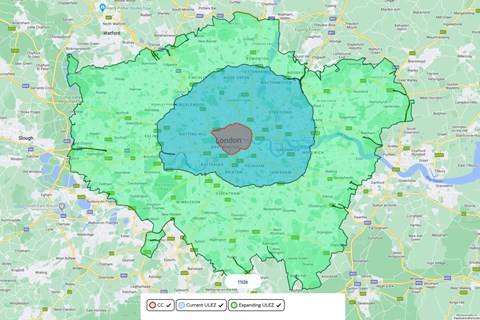► Ultra Low Emissions Zone goes London-wide
► £110m scrappage scheme to support transition
► Promise of improved public transport, too
Some residents of London have started receiving reminders about the upcoming expansion of the Ultra Low Emission Zone (ULEZ), which is set to take place on 29 August 2023.
The ULEZ will grow to cover the entire London area on this date, with the new borders drawn up to the existing Low Emissions Zone.
The expansion was originally announced in November 2022 and follows a previous expansion in October 2021, after the launch of the ULEZ in 2019. The new zone will mean improved air quality for 5 million more Londoners, according to the official documentation.
Projections estimate that the expansion will save 27,000 tonnes of CO2 in outer London – nearly double what the original ULEZ achieved in its first year of operation. NOx and particular emissions will also be reduced.
Compliance with the current ULEZ is now at 94 per cent, and official figures reckon that the new outer London area is already around 85 per cent in line with the standards required (there’s more on these below). Suggesting only about 15 per cent of users will be affected by the change and have to pay if they want to continue driving their current car.
In an effort to offset the financial impact of changing to a more modern car, the increased ULEZ will be supported by a new £110m scrappage scheme fund. This will be targeted at those most likely to be suffering under the current cost of living crisis, namely Londoners on lower incomes, those who are disabled, charities, small businesses and sole traders.
There are also promises of improved public transport to go with the expansion.
So how much does the ULEZ charge cost, what’s it for and when do you need to pay it? Keep reading for CAR magazine’s guide to the London Ultra Low Emission Zone.
How big is the new 2023 ULEZ?
The new ULEZ extends to cover the area currently defined by the older Low Emissions Zone, taking in all London boroughs in the process.

Below is the sign that signals you’re approaching the ULEZ. You can check also before you set off using the official government London ULEZ postcode checker tool.

What time of day does the ULEZ operate?
Unlike the London Congestion Charge, there is no operating time for the ULEZ charge; if you enter at any time of the day or night, you’ll have to pay. After all, this is about stopping emissions, not traffic at peak hours.
More bad news: the charge is calculated per calendar day, so if you drive in to the ULEZ area at 11pm at night and then drive out at 2.30am the following morning, you’ll have to pay the charge twice.
How much does the ULEZ cost and how do you pay it?
If your vehicle is affected, you’ll have to pay an extra £12.50, and if you’re using a larger vehicle (such as a lorry over 3.5 tonnes or a coach over 5 tonnes), it’ll cost an extra £100 per day. As with the Congestion Charge, you can pay online, and even in advance.
Remember, this is in addition to the London Congestion Charge, so if you’re going through during the Congestion Charge’s operating time, too, you’ll have to pay both tolls.
What’s the fine if you don’t pay the ULEZ?
If you don’t pay the ULEZ charge you’ll be fined £160, though that halves to £80 if you pay quickly.
How to check if your vehicle is affected
ULEZ charges are calculated on the emissions a vehicle produces rather than the car’s age, and the minium emission standards for petrol and diesel cars are below:
- Petrol: Euro 4
- Diesel: Euro 6
If your car fails to meet those standards, you’re going to pay the charge, so this will only affect older cars. According to the TFL’s website, most petrols registered after 2005 will pass the Euro 4 protocols, although some cars from 2001 onwards may also be okay. In terms of diesels, most vehicles bought after September 2015 will generally pass the ULEZ standard.

You can find out if your vehicle passes with TFL’s registration plate checker.
What about classic cars?
If you’re a classic car owner there’s some better news. Cars built more than 40 years ago (those exempt from VED road tax) will also be exempt from the ULEZ charge. So anything made before 1 January 1983 qualifying for historic vehicle tax will be exempt from the new ULEZ charge.
Be aware, that historic vehicle tax doesn’t include commercial vehicles though.
Should you still buy diesel cars? Our handy petrol vs diesel explainer